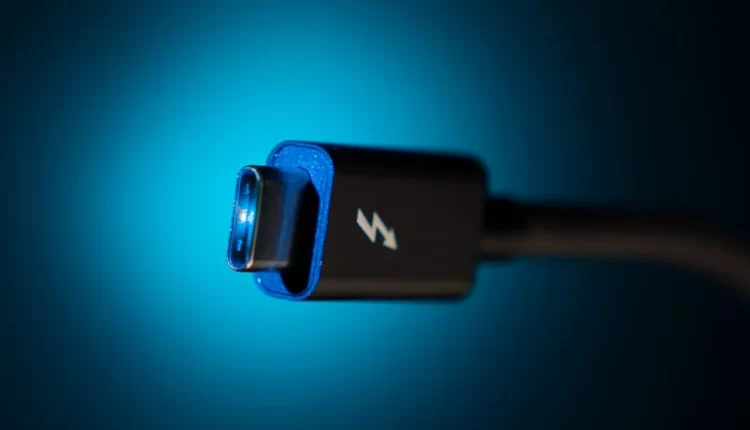The tech world is abuzz with excitement as the latest in connectivity standards takes center stage. USB-C enthusiasts have a lot to look forward to, as not only is the iPhone embracing this technology, but there’s also a new contender in town – Thunderbolt 5. Thunderbolt 5, which utilizes the USB-C connector, promises lightning-fast data transfer speeds, but its true competition isn’t what you might expect.
Thunderbolt’s Evolution
You might be wondering why Thunderbolt 5 is generating so much buzz, especially when its predecessor, Thunderbolt 4, was considered a powerhouse. To understand its significance, we need to delve into the world of USB and Thunderbolt connectivity.
Thunderbolt 4, although impressive, is no longer the reigning champion of high-speed data transfer. Thunderbolt 5 has set its sights on a new contender: USB 4v2. Thunderbolt 5’s key goal is to surpass USB 4v2 in both data transfer speeds and power delivery capabilities. At first glance, Thunderbolt 5 might appear similar to USB 4v2, boasting a maximum data rate of 80 Gbps in each direction (or an asymmetric mode with 120 Gbps one way and 40 Gbps the other). So, what sets Thunderbolt 5 apart?
The Power and Speed of Thunderbolt 5
The key differentiation lies in the power and speed Thunderbolt 5 offers. Thunderbolt 5 aims to provide a higher performance floor compared to USB 4v2. While both can optionally handle up to 240 watts of charging, there’s no guarantee that USB 4v2 ports can deliver this amount of power. Thunderbolt 5, on the other hand, mandates at least one computer port capable of charging a PC with up to 140 watts of power and 15 watts for accessories, in contrast to USB 4’s minimum requirement of just 7.5 watts. This means Thunderbolt 5 can deliver extra power, particularly to high-end laptops, offering a significant improvement over Thunderbolt 4.
In terms of data transfer rates, Thunderbolt 5 sets a minimum of 80 Gbps, a notable leap from the 20 Gbps minimum of USB 4. This increased speed is crucial for various applications, including connecting monitors, storage devices, and external GPUs.
Practical Implications
When transferring data over the PCI Express 4.0 bus supported by Thunderbolt 5, you’ll enjoy 64 Gbps of speed. This is roughly equivalent to four PCI Express 4.0 lanes, making it ideal for a wide range of applications. Thunderbolt 5 is positioned as a significant enhancement for external GPU enclosures, as it doubles the PCI Express bandwidth compared to Thunderbolt 4. While it may not match the performance of a full-length internal slot, it still provides a noticeable boost over existing solutions. This speed also benefits external SSDs, making it a valuable tool for video editors working with large amounts of data.
Higher Data Rates for Monitors
One of the standout features of Thunderbolt 5 is its capacity to handle higher data rates. In addition to matching USB 4v2’s data transfer speeds, Thunderbolt 5 can accommodate even more demanding setups, like a pair of Daisy-chained 6K monitors. This resolution might seem unusual, but it’s common in professional-grade displays. For standard or gaming setups, Thunderbolt 5 can power three 4K displays at 144 Hz. Thunderbolt 5 automatically switches to 120 Gbps mode when a display requires the extra bandwidth, providing unparalleled flexibility and performance.
When to Expect Thunderbolt 5
You might be eager to get your hands on Thunderbolt 5, but you’ll need to be patient. The first devices featuring Thunderbolt 5 are expected to hit the market in 2024. It’s important to note that Thunderbolt 5 will likely be a technology primarily favored by enthusiasts seeking higher bandwidth and power capabilities. For those who only require basic USB power delivery, USB 4v2 might suffice.
In conclusion, Thunderbolt 5 is a promising leap forward in connectivity technology, offering higher data transfer speeds and enhanced power delivery. While its debut is on the horizon, it may take some time before it becomes a staple in everyday technology. Until then, we can only anticipate the exciting possibilities Thunderbolt 5 will unlock in the world of high-speed, high-power connectivity.
In case you have found a mistake in the text, please send a message to the author by selecting the mistake and pressing Ctrl-Enter.
#Exploring #Thunderbolt #Future #Connectivity


